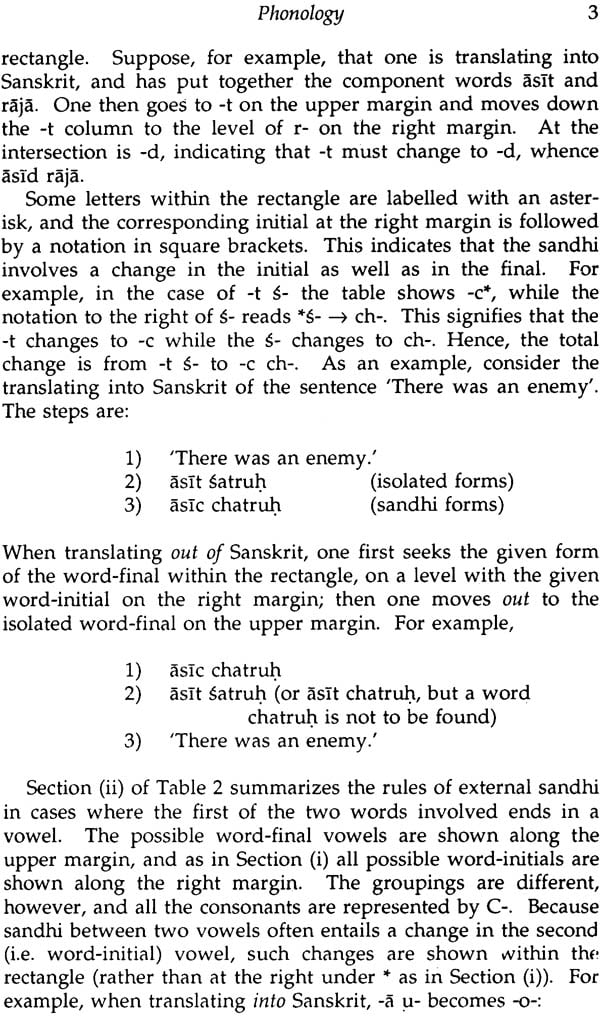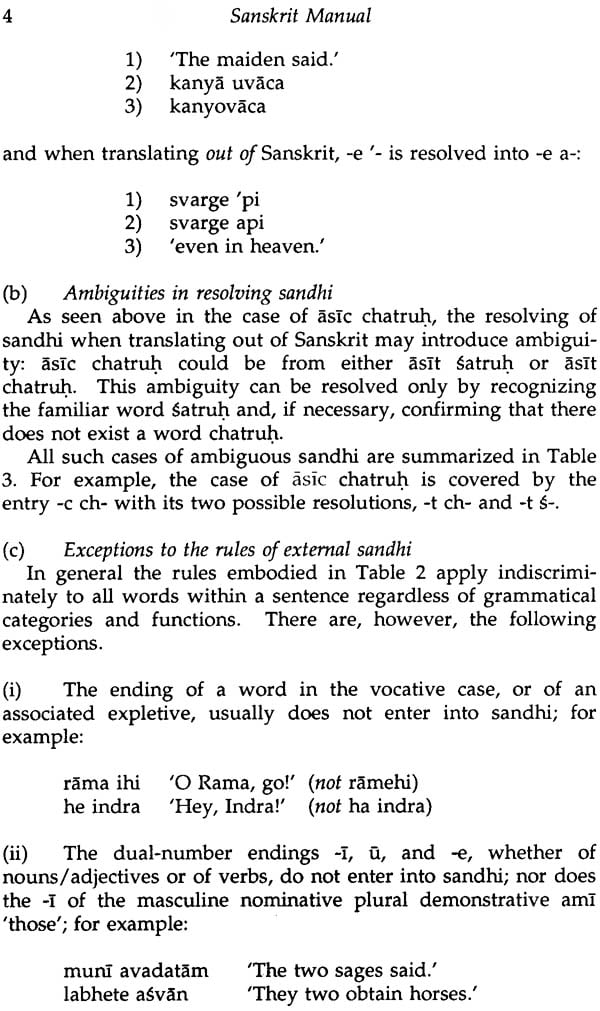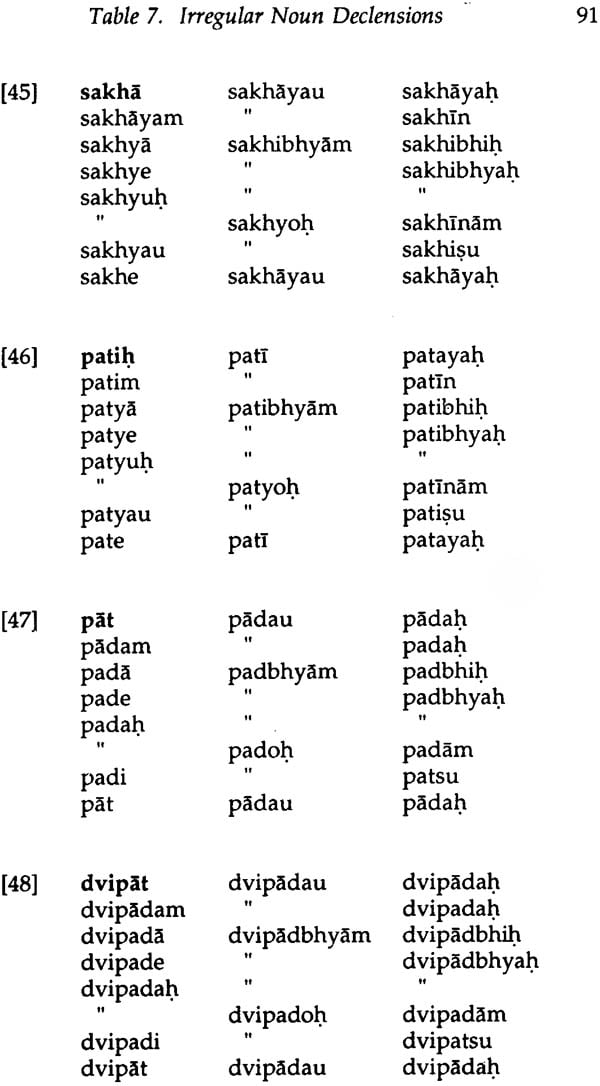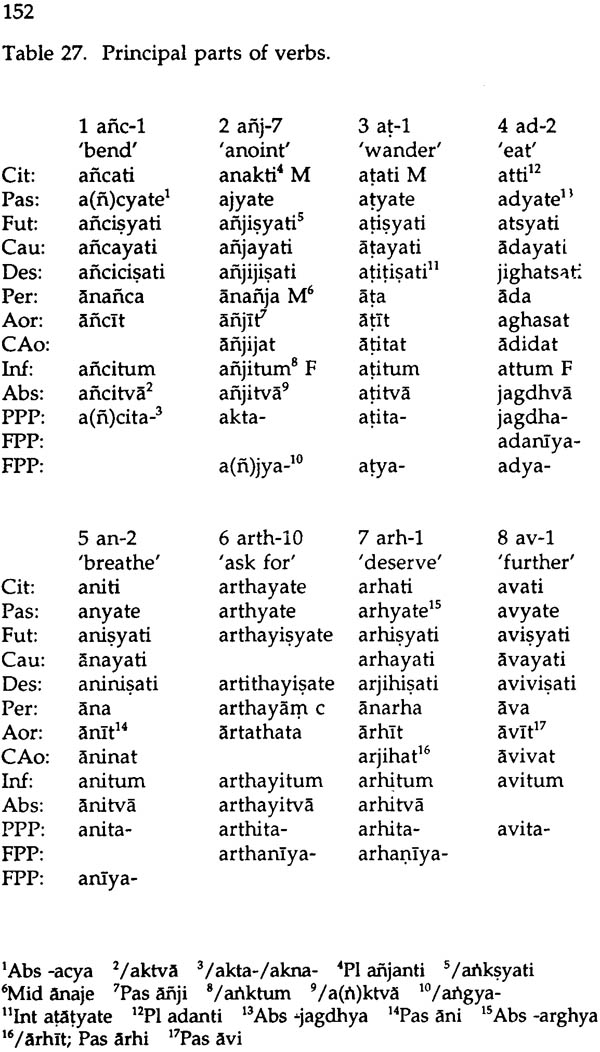
Sanskrit Manual
Book Specification
| Item Code: | IDD396 |
| Author: | Roderick S. Bucknell |
| Publisher: | Motilal Banarsidass Publishers Pvt. Ltd. |
| Language: | English |
| Edition: | 2006 |
| ISBN: | 9788120811898 |
| Pages: | 263 |
| Cover: | Paperback |
| Other Details | 8.5" X 5.5" |
| Weight | 350 gm |
Book Description
This book is a convenient quick reference guide to the phonology and grammar of Classical Sanskrit, for use by University students and others. It presents, in easily read tables, essential reference information such as the rules of sandhi, the declensional and conjugational paradigms, and the principal parts of major verbs. Tables make up about two-thirds of the book. The remainder is text, with guidance on how to use the tables and explanations of the relevant grammatical principles. Romanized transcription is used throughout, and some innovative modes of description and presentation are adopted. Particular features are a table of the principal parts of 432 verbs, and a set of three indexes - to verb stems, verb endings and noun endings. This Manual will be found a valuable, 'user - friendly' companion to existing grammars, such as Whitney's. Though primarily intended for beginning and intermediate students, it will be of use to scholars working with Sanskrit at any level.
RODERICK S. BUCKNELL studied and travelled extensively in India and other Asian countries, before returning to Australia to do a Ph. D. in linguistics. He is currently Senior Lecturer in Chinese and Indian religions at the University of Queensland. His thoughts on the methodology of teaching and learning Sanskrit derive in part from his own early experience as a student of the language. He studied it both in India, under a pandit following completely traditional methods, and in Australia, under a specialist in Indo - European historical linguistics - contrasting approaches that highlighted some fundamental methodological issues. Besides linguistic problems Dr. Bucknell's research and publication covers various aspects of Buddhist studies.
This book is designed to serve as a convenient quick-reference guide to the grammar of Classical Sanskrit, for the use of university students and others. It is not intended to be a complete grammar of the language. Rather, its purpose is to present, mainly in the form of easily read tables, essential reference information such as the rules of sandhi, the declensional and conjugational paradigms, and the principal parts of major verbs.
About two-thirds of the book consists of tables. The remainder is text, with advice on how to use the tables and explanations of the grammatical principles underlying them. Most of the grammatical information has been abstracted, with substantial modification of the presentation, from existing Sanskrit grammars, especially those of Whitney, MacDonell, and Kale. An exception is the set of three indexes: ‘Index to verb stems’, ‘Index to verb endings’, and ‘Index to noun endings’ (Tables 28-30). These probably have no counterpart elsewhere.
The manual originated as a set of photocopied notes which was supplied, as a supplement to existing textbooks, to first and second year students of Sanskrit in the Department of Studies in Religion at The University of Queensland. Over a period of seven years those notes were progressively modified and expanded until they became the present fairly comprehensive reference work. While still primarily intended for beginning and intermediate students, the manual should also be found useful by scholars working with Sanskrit at any level.
Much of the difficulty encountered by students of Sanskrit is due, it can be argued, to unsatisfactory presentation. This derives largely from a tendency, on the part of those who compile Sanskrit textbooks, to accept uncritically the traditional grammarians’ concepts and modes of description. In this manual that tendency has been resisted. Certain concepts and modes of description that are very firmly established in the tradition of Sanskrit grammar are set aside in favour of ones that are self-evidently simpler and more appropriate. To this extent the present work is innovative - and no doubt also controversial. The nature of the innovative features will become apparent in the section on ‘Principles of presentation’.
Scope
The range of grammatical categories covered in the manual is maximally wide. I recognize that some of the categories dealt with (e.g. the precative, and the causative aorist) are rare, and that the information given on them is of correspondingly limited use. I maintain, however, that their inclusion serves an important function: gaining a panoramic view of the total grammatical landscape makes one better able to appreciate those sections of it that one is already familiar with. For example, Table 15, which purports to set out all the conjugational forms of a representative verb (nayati), no doubt contains a number of forms that are unlikely to be encountered in practice; yet their inclusion serves the important function of completing the conjugational picture. Daunting as that total picture may be, it enables the student to see how known conjugational patterns fit within the overall framework.
As regards the scope of the two tables dealing with specific verbs, ‘Principal parts of verbs’ (Table 27) and ‘Index to verb stems’ (Table 28), the choice of verbs to be included was determined ultimately by the content of Lanman’s Reader. The two tables cover every verb (apart from exclusively Vedic ones) contained in Lanman, to a total of 432. This ensures that the manual meshes in well with students’ continuing studies, since Lanman seems likely to remain a major text in university Sanskrit courses for many years to come.
Principles of presentation
The main medium of presentation is carefully designed tables. These, by setting out the information in visual, picture- like form, facilitate comprehension and eventual mastery of the patterns, as well as being the most convenient format for reference purposes. For example, the rules of external sandhi, which most grammars and primers present in the form of numerous verbal statements, are here presented as a single table. This reveals at a glance not only the individual rules but also the broad phonetic principles underlying them. (Probably the only previous textbook to make use of such a table is Coulson’s.)
Roman transcription is used rather than devanagari. Certain characteristics of the devanagari script, particularly the frequent departures from a simple left-to-right sequence of consonant and vowel letters, make it rather unsuitable as a medium for presenting grammatical information (by obscuring regularities and patterns of correspondence). The roman transcription, besides being free of these defects, has certain positive pedagogical advantages. For example, its use of subscribed dots, though typographically troublesome, draws attention to the internal sandhi rules relating to retroflexion - as in instances like visena.
The grammatical terminology is in English rather than Sanskrit. For example, the terms ‘active’ and ‘middle’ are used instead of the traditional ‘parasmaipada’ and ‘atmanepada’. The English terminology, while possibly lacking the precision and specificity of the Sanskrit, has certain overriding advantages. Apart from being self-evidently easier for the English-speaking student to understand and work with, it is in many instances considerably more informative; for example, ‘dative case’ conveys information that ‘caturthi vibhakti’ does not.
In the case of the ten verb classes, the traditional names are abandoned entirely, as being mnemonically not very helpful. For example, for the ninth class the term ‘kryadigana’, derived from the type representative verb krinati, is replaced by ‘-nati verbs’ or ‘the -nati class’, derived from the characteristic conjugational ending.
| List of tables | vii | |
| Preface | ix | |
| PART I:PHONOLOGY | ||
| 1. | The speech-sounds | 1 |
| 2. | External sandhi | 1 |
| 3. | Internal sandhi | 5 |
| 4. | Vocalic gradation | 7 |
| 5. | Alphabetic sequence | 9 |
| PART II:GRAMMAR | ||
| A.Nominals | 11 | |
| 1. | Nouns | 11 |
| 2. | Adjectives | 14 |
| 3. | Numerals | 29 |
| 4. | Demonstratives | 32 |
| 5. | Pronouns | 32 |
| B.Verbs | 34 | |
| 1. | Present and Imperfect | 41 |
| 2. | Perfect | 47 |
| 3. | Aorist | 50 |
| 4. | Precative | 53 |
| 5. | Periphrastic future | 54 |
| 6. | Simple future and conditional | 54 |
| 7. | Passive voice | 55 |
| 8. | Secondary conjugations | 56 |
| 9. | Participles | 59 |
| 10. | Non-finite verb-forms | 63 |
| 11. | Verbal roots and the ten verb classes | 64 |
| 12. | Using the verb tables | 65 |
| 13. | Using the indexes | 68 |
| Tables 1 to 30 | 71 | |
| Abbreviations | 253 | |
| Bibliography | 255 |

















